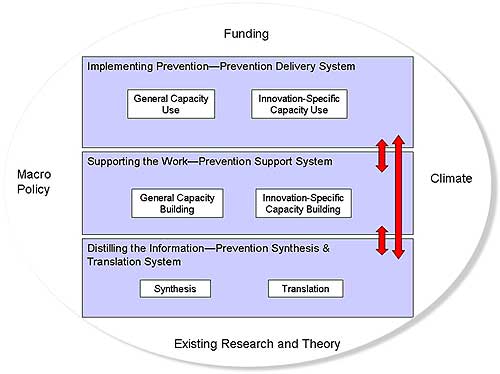
Intimate Partner Violence Prevention
Scientific Information: Translation
Translation characterizes the sequence of events from discovery of new knowledge (i.e., an innovation) to its adoption and use in practice settings. It does not encompass pure foundational or formative basic "discoveries" (e.g., discovery of risk and protective factors, causal pathways, or etiology research). Translation is comprised of many complex activities of which the specifics elements are defined below.
- Dissemination: The intentional
targeted spreading of information or technology about an innovation -
product, practice, program, policy, idea, research findings, or results
- from the originators to the intended users (specific public health
audiences and other key stakeholders receptive to them). The result is a
targeted and facilitated process of distributing information and
materials to organizations and individuals who want and can use them to
improve health.
- Implementation: A purposeful set of
specific activities designed to put an innovation idea, product,
policy, program or practice to use, including the decision to use an
innovation, commitment of needed resources, and actual use. The result
is individual or organizational adoption of an innovation - product,
practice, program, policy, idea, research findings, or results.
- Diffusion: Processes whereby an innovation -- product, practice, program, policy, idea, research findings or results moves into widespread use or common understanding. The result is the uptake of new practices, the penetration of broad scale recommendations, or more evidence-based health decision-making in both the public and the private sectors. Strategies to influence diffusion may include dissemination and implementation initiatives, marketing, laws and regulations, systems research, and policies.1
Overview of the Interactive Systems Framework for Dissemination and Implementation
The Interactive Systems Framework for Dissemination and Implementation shows key elements and relationships involved in the movement of knowledge of research into practice. While it is primarily descriptive, it also has implications for how the dissemination and implementation process might be improved. The Framework consists of three systems: the Prevention Synthesis and Translation System, the Prevention Support System, and the Prevention Delivery System. The term system is used broadly here to describe a set of activities that may vary in the degree to which they are systematic or coherently organized.
The function of the Prevention Synthesis and Translation System is conceptualized as distilling information about scientific innovations and preparing them for implementation by end users (e.g., practitioners). The function of the Prevention Support System is conceptualized as supporting the work of those who will put the innovations into practice. The primary function of the Prevention Delivery System is the implementation of innovations (e.g., delivery of programs) in the field.
The Interactive Systems Framework for Dissemination and Implementation1

Translational Research
Research is continuing to identify programs and strategies that reduce or ultimately prevent various types of violence. For these programs or strategies to reach the broadest audience possible, applied translational research about their dissemination, implementation, and diffusion is necessary. For example, a program's effectiveness may vary depending on the setting in which it is delivered. Translational research may examine the effect of a program in different settings including the workplace, schools, churches, and community centers. CDC's research on translation helps guide the adaptation of programs and strategies to specific communities, subcultures, and populations with the goal of enhancing their effectiveness.
A special issue of the American Journal of Community Psychology was published in April 2008 highlighting the Interactive Systems Framework for Dissemination and Implementation.
Resources
Domestic Violence Prevention Enhancement and Leadership Through Alliances (DELTA)
The DELTA program encourages the development of comprehensive prevention strategies through a continuum of activities that address all levels of the social ecology. State coordinators provide training to organizations that undertake primary prevention activities.
National Implementation Research Network
The National Implementation Research Network seeks to close the gap between science and service by improving the science and practice of implementation in relation to evidence-based programs and practices.
National Youth Violence
Prevention Resource Center (NVPRC)*
Developed by CDC in partnership with 10 other federal partners, the NVPRC
provides information pertaining to youth violence that has been developed by
federal agencies and the private sector. The NYVPRC is a gateway for
professionals, parents, teens, and other interested individuals to obtain
comprehensive information about youth violence-including teen dating
violence.
Prevention Connection: The
Violence Against Women Prevention Partnership*
Prevention Connection, a project of the California Coalition Against Sexual
Assault, features an online public Listserv and bi-monthly Web-based forums.
The Listserv and Web forums provide prevention experts with a vehicle for
analyzing and discussing ongoing efforts to prevent domestic and sexual
violence.
Violence Against Women
Electronic Network*
The National Online Resource Center on Violence Against Women (VAWnet)
provides a collection of full-text, searchable resources on domestic
violence, sexual violence, and related issues. It also provides links to an
"In the News" section, a training calendar, conferences, grants, and access
to the Domestic Violence Awareness Month and Sexual Assault Awareness Month
subsites.
Reference
1 Wandersman, A., Duffy, J., Flaspohler, P., Noonan, R., Lubell, K.,
Stillman, L., Blachman, M., Dunville, R., & Saul, J. (2008). Bridging the
gap between prevention research and practice: The Interactive Systems
Framework for Dissemination and Implementation. American Journal of
Community Psychology, 41, 171-181.
* Links to non-Federal organizations found at this site are provided solely as a service to our users. These links do not constitute an endorsement of these organizations or their programs by CDC or the Federal Government, and none should be inferred. CDC is not responsible for the content of the individual organization Web pages found at these links.
Content Source:
National Center for Injury
Prevention and Control, Division of Violence Prevention
Page last modified:
October 28, 2008
